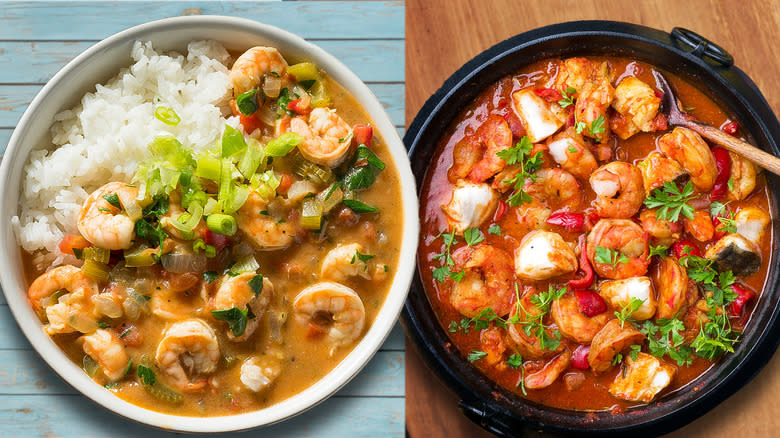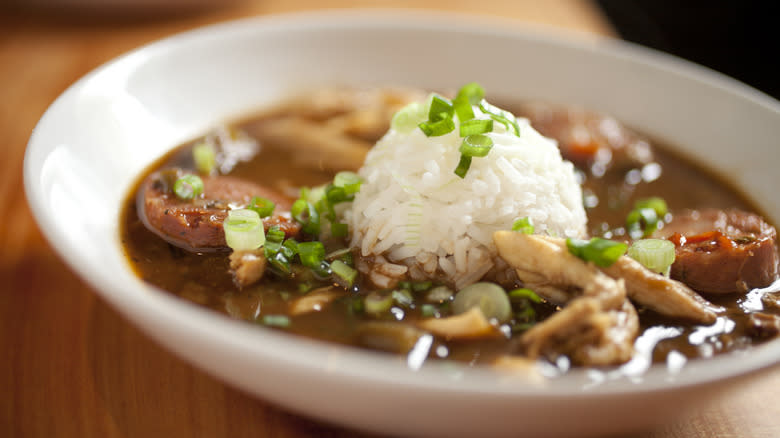The Difference Between Etouffée And Gumbo

Of all the delicious foods Louisiana has to offer, étouffée and gumbo may be the most similar in terms of flavors and technique even though they come from different culinary backgrounds. The use of common ingredients may lead you to mistake one for the other, but there are key differences you should recognize. First, gumbo is a soup. No matter how thick or thin, gumbo is a deeply flavorful broth-based recipe, usually served with a scoop of rice in the bowl. Étouffée is not a soup. It's a sauce-based recipe usually containing seafood and served on a bed of rice.
The confusion lies in the similar flavors both recipes share from their base of roux and the Cajun trinity of onion, celery, and bell pepper. While it's true that both may showcase seafood delicacies from the waterways of Louisana, gumbo usually contains a much more diverse set of ingredients, including sausage, rabbit, chicken, or tasso ham.
Read more: Styles Of Regional BBQ In The US
What Is étouffée?

Translated, étouffée means "smothered," and in this case, it involves smothering seafood in a well-seasoned sauce until tender and infused with the surrounding flavors. Crawfish is the most prevalent variation in southern Louisiana and was the original version that was developed in the 1920s, but you'll see all manner of seafood cooked in this manner and, occasionally, even chicken. The dish is characterized by a thick, flavorful blonde roux-based sauce, enhanced with the holy trinity of Cajun cuisine: onions, celery, and bell peppers.
As in many recipes from New Orleans, you'll see several versions of étouffée on menus, with a distinction between the more rustic Cajun versions with dark brown roux and Creole renditions with a lighter, butter-based roux and tomatoes added to the sauce. The emphasis is on a plentiful serving of seafood, no matter how dark or light the sauce is colored. Both are equally delicious and traditionally served on a bed of steamed white rice.
What Is Gumbo?

Gumbo has roots in West African cooking and features ingredients native to the Louisiana bayous. With rustic origins, gumbo is adaptable to the ingredients on hand — seafood, chicken, sausage, and country ham are some of the main flavors you might encounter. The base of the soup is flavored with the trinity of onion, celery, and bell pepper, along with a hearty dose of Cajun seasoning.
The name gumbo is said to come from the West African word for okra, which is a common ingredient used to thicken the soup. When okra isn't available, some cooks use ground sassafras, also known as filé, and others turn to the European method of cooking flour and fat together into a roux, but in this case, a dark brown version. As gumbo migrated from kitchen to kitchen, the recipes evolved, so there's no one traditional gumbo but a whole family of soups that mostly have the Cajun trinity vegetables in common.
Roux-thickened, deep-brown gumbo is one of the more common versions you'll find on menus and resembles étouffée in color and flavor, but with much more broth. Creole gumbo might include tomatoes and okra, and there's a version called gumbo z'herbes, which is full of greens. Gumbo is traditionally served with white rice, either as a scoop on top or on the side of the bowl to stir in. The rice absorbs the brothy flavors, making gumbo a hearty and filling dish.
The Choice Of Meat And Seafood Distinguish These Two Recipes

Although both étoufée and gumbo are based on tasty roux and that delicious Cajun version of mirepoix, you'll find a much wider variety of ingredients in most gumbo recipes than you will in étoufée. Étoufée is normally based on one central protein ingredient, and the traditional choice is crawfish or shrimp. You also won't find okra or sassafras filé in étoufée, but those are both common ingredients in gumbo recipes.
The cooks in the bayou country of Louisiana are skilled at using ingredients at hand to make delicious creations. The origins of gumbo and its adaptable set of ingredients are what make it stand out from étoufée as a rustic, filling way to put food on the table. If crabs, oysters, and sausage are available, that's what will be in the gumbo. If not, any number of local meats or seafoods will be in the soup, balanced with okra and tomatoes or seasoned with filé — gumbo recipes are an expression of the cook's ingenuity to create flavorful combinations.
Read the original article on Tasting Table.

